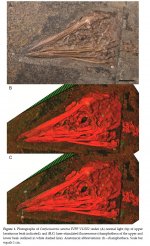Fred Ruhe
Well-known member

Amanda Falk, Jingmai O’Connor, Min Wang and Zhonghe Zhou, 2019
On the Preservation of the Beak in Confuciusornis (Aves: Pygostylia)
Diversity. 11 (11): Article 212. doi:10.3390/d11110212
Abstract and free pdf: https://www.mdpi.com/journal/diversity/special_issues/Avian_Biodiversity
Abstract:
The Confuciusornithiformes represent the most stem-ward avian occurrence of an edentulous rostrum. Although a keratinous beak is widely considered to have covered the rostrum in confuciusornithiforms, this feature is almost never preserved, having been previously reported only in the holotype of Confuciusornis dui and the holotype of Eoconfuciusornis zhengi. This strongly contrasts with the widespread preservation of the keratinous sheaths that cover the manual and pedal ungual phalanges. Here, we report on a third occurrence of a preserved rhamphotheca in a specimen of Confuciusornis sanctus. We illuminated the preserved traces using laser-stimulated fluorescence. Similarly to E. zhengi, the rhamphotheca has been preserved only as a two-dimensional trace, whereas ungual sheaths are preserved in three dimensions. In contrast to the traces preserved in C. dui, the rhamphotheca in the discussed specimen of C. sanctus is straight rather than upturned. This hints towards hidden morphological diversity within the thousands of Confuciusornis specimens, in which species may be further differentiated by soft tissue features or behaviors, much like many living birds, that cannot be detected in fossils, even with exceptional preservation.
This paper is part of a Special Issue "Origins of Modern Avian Biodiversity"
2019 Other papers, already discussed:
Total-Evidence Framework Reveals Complex Morphological Evolution in Nightbirds (Strisores)
by Albert Chen , Noor D. White , Roger B.J. Benson , Michael J. Braun and Daniel J. Field
Diversity 2019, 11(9), 143; https://doi.org/10.3390/d11090143 - 23 Aug
New Material of Paleocene-Eocene Pellornis (Aves: Gruiformes) Clarifies the Pattern and Timing of the Extant Gruiform Radiation
by Grace Musser , Daniel T. Ksepka and Daniel J. Field
Diversity 2019, 11(7), 102; https://doi.org/10.3390/d11070102 - 28 Jun 2019
Enjoy,
Fred
On the Preservation of the Beak in Confuciusornis (Aves: Pygostylia)
Diversity. 11 (11): Article 212. doi:10.3390/d11110212
Abstract and free pdf: https://www.mdpi.com/journal/diversity/special_issues/Avian_Biodiversity
Abstract:
The Confuciusornithiformes represent the most stem-ward avian occurrence of an edentulous rostrum. Although a keratinous beak is widely considered to have covered the rostrum in confuciusornithiforms, this feature is almost never preserved, having been previously reported only in the holotype of Confuciusornis dui and the holotype of Eoconfuciusornis zhengi. This strongly contrasts with the widespread preservation of the keratinous sheaths that cover the manual and pedal ungual phalanges. Here, we report on a third occurrence of a preserved rhamphotheca in a specimen of Confuciusornis sanctus. We illuminated the preserved traces using laser-stimulated fluorescence. Similarly to E. zhengi, the rhamphotheca has been preserved only as a two-dimensional trace, whereas ungual sheaths are preserved in three dimensions. In contrast to the traces preserved in C. dui, the rhamphotheca in the discussed specimen of C. sanctus is straight rather than upturned. This hints towards hidden morphological diversity within the thousands of Confuciusornis specimens, in which species may be further differentiated by soft tissue features or behaviors, much like many living birds, that cannot be detected in fossils, even with exceptional preservation.
This paper is part of a Special Issue "Origins of Modern Avian Biodiversity"
2019 Other papers, already discussed:
Total-Evidence Framework Reveals Complex Morphological Evolution in Nightbirds (Strisores)
by Albert Chen , Noor D. White , Roger B.J. Benson , Michael J. Braun and Daniel J. Field
Diversity 2019, 11(9), 143; https://doi.org/10.3390/d11090143 - 23 Aug
New Material of Paleocene-Eocene Pellornis (Aves: Gruiformes) Clarifies the Pattern and Timing of the Extant Gruiform Radiation
by Grace Musser , Daniel T. Ksepka and Daniel J. Field
Diversity 2019, 11(7), 102; https://doi.org/10.3390/d11070102 - 28 Jun 2019
Enjoy,
Fred




